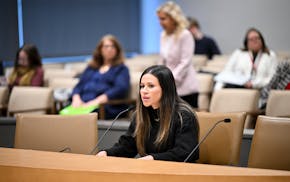After 55 years, Children's Country Day School plans to close at the end of this summer. Last week, Children's Center Montessori ended a 53-year run. And 42-year-old Sandcastle Early Learning Center also shuttered last month.
Before that, two other St. Paul child care centers — both of which served kids for more than 90 years — closed their doors.
"They weathered the Great Depression and World War II, OK? What is happening in 2025?" asked Celeste Finn, executive director of Big Wonder Child Care.
Providers, parents and government leaders assembled at Big Wonder on Thursday to talk about the spate of St. Paul-area closures and what's needed across the state to stop others from following suit.
Meanwhile, dozens of families have been scrambling to find care.
When Dustin Cripe heard Children's Country Day School was closing, he immediately started making calls to get on waitlists. The West St. Paul resident has two kids who have graduated from Children's County Day, one going there now and a fourth the family planned to send to the center.
"It's an idyllic childhood development experience," Cripe said, with a 7-acre campus that has horses, llamas, chickens and a vegetable garden. He said he was shocked "a staple of the community" that is loved by families and has a waitlist would close.
"Communities need to support these places before they disappear and then we're in an even worse position. I don't know how to fix it," he said, "But this seems like it's a downward spiral."
Tough-to-sustain model
Child care owners and staff describe a host of problems making it hard to continue.
Low pay for challenging work makes it difficult to attract and keep staff. Burnout continues to be high post-pandemic. Profit margins can be razor-thin — particularly if providers are trying to keep their rates more affordable, offer staff better pay and benefits or maintain lower staff-to-child ratios. And inflation is eating further into those margins.
Sandcastle Early Learning Center leadership described their closure as the culmination of "insurmountable" financial and operational challenges in an email to the Minnesota Star Tribune. They faced annual deficits of more than $150,000, rising costs and "severe qualified workforce shortages" with staff-to-child ratio requirements making staff absences hard to manage and an inability to find substitute staff.
They noted new policies — including earned sick and safe time and the upcoming paid family and medical leave program — that compound challenges. As has the shift toward publicly funded pre-K for 4-year-olds, who generate more money for centers than younger kids, Sandcastle officials said.
"Without long term structural solutions such as sustained public investment in early care infrastructure, workforce development, and flexible operating support, even the most established and well loved programs remain one staffing crisis away from closure," they wrote.
Child care staff and directors echoed those ideas at Thursday's discussion, where they said their industry has long been undervalued. Organizers tried to rally attendees to push for more funding in the next state budget, in 2027.
It was the second event of its kind this year. In February, dozens of child care workers and some government officials gathered at Hallie Q. Brown Community Center in St. Paul to discuss similar woes.
Hallie Q. Brown's Early Learning Center — which, at nearly 100 years old, was considered one of the state's oldest centers — closed at the end of January, with officials citing staffing challenges. That followed the closure of the 93-year-old early childhood center at St. Catherine University in May 2024.
Seeking public funds
Recent closures have a "devastating impact" that ripples through the community and also impacts employers, said Rep. Dave Pinto, DFL-St. Paul. More public investment is needed in early education nationwide, he said, citing New Mexico's dedicated funds for early childhood as a potential model.
"Once a kid turns 5, we recognize that education and care is a public good," Pinto said. "We have a hard time getting our minds around it for younger kids, when, in fact, it's at least as important."
Legislators, wielding a significant surplus two years ago, temporarily boosted child care funding, including a major one-time increase to early learning scholarships for families.
With a difficult budget picture now, lawmakers won't be making one-time child care spending boosts in the next budget, said DFL Rep. Carlie Kotyza-Witthuhn, co-chair of the Children and Families Finance and Policy Committee. She said her goal this year was to avoid cutting into base-level child care funds.
"My top priority was we not go backwards," she said, noting state leaders are also watching for potential federal cuts.
Looking ahead, Kotyza-Witthuhn said there are many options to support child care, like using money from certain tax exemptions or seeking a constitutional amendment for a specific dedicated tax.
"Raising taxes is always a hot-button issue," she said. "But I think when we look at it for a specific issue and how we could potentially solve the child care crisis, I think that's something we all are invested in. It just needs to be done responsibly."
U faculty and students fear budget cuts and tuition hikes will reduce staffing and enrollment

New report details how to improve MN's foster care system

Four arrested, no one injured in fighting and shooting following Burnsville High School graduation

One man dead in shooting Friday outside Northtown Mall in Blaine
